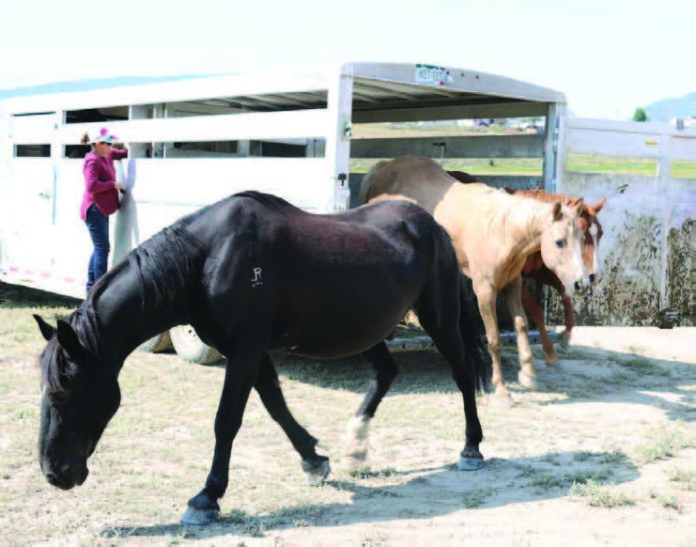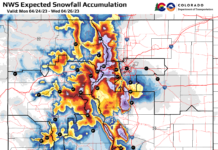
by Christy Parrott
From afar, the Silver Creek fire may be something to send well wishes after, perhaps even admire in its terrible awe. But up close, at the grassroots level— exactly where the fire is hitting ranchers and farmers—an entire community braces itself for the initial and long-term effects of what will likely take years to recover.
To date, over 4745 acres have burned both private land and national forest near Sarvis Creek, Silver Creek and Red Dirt Creek (Red Dirt reservoir area) with only 27 percent contained. As homes have been evacuated, ranchers have scrambled to move their herds to safer locations. A local rancher, who wishes to remain anonymous, reports: It’s a loss of feed, a loss of habitat. The elk and deer will be displaced to different areas. The cover is gone; the land is gone. The amount of human contact with the game has changed, because of the noise conflict with the choppers, the scent control, it’s all been altered. The cattle grazing has been devastated It could have been controlled. Now, the weeds will grow
back.
Ironically, plans to manage the timber were in the works, according to Aaron Voos of the National Forest Service, “We knew that the area needed treatment and had plans to do so. There was an active timber sale north of Buffalo Park since last year.” Apparently, the forest service had been planning treatments for the area “Since the beetle kill epidemic,” with additional plans for just north of Old Park, which may still be viable, depending on the fires. However, “It appears the fire was burning hot enough to blow right through the clear-cut areas or spot over the top,” Voos explains.
“Areas that had been logged in the last twenty to thirty years with non-mature trees standing have been very susceptible to the fire.”
“They’re spending a lot of money putting out a fire that could have been more
effectively logged to reduce fire and prevent spreading,” Randy George explains. As far as the National Forest Service’s plans to log the area, George feels, “They’re about eight to nine years too late.”
Randy George and his wife, Lisa, have experienced devastating financial loss and a radically altered environment in which to operate their Latigo Ranch.”Until Monday morning, it was the normal guest routine,” Lisa George says. “Then smoke made it’s way to us, and it looked like it was evening, so we knew things had changed.” Latigo Ranch, one of the first properties to be evacuated, had to be out by dark. Fortunately, Randy and Lisa George had an evacuation plan in place for over 20 years. “Everyone stepped up and did their jobs,” Lisa George explains. “Still, we didn’t factor that three ranch hands had vehicles that needed to be moved, so guests stepped in to help.”
Latigo Ranch had to move 69 horses to the Taussig ranch’s lower meadows, seven miles away. “It’s like we’re in a war zone,” Caitlyn Taussig describes, “Moving herds while helicopters buzzed just overhead.” Lisa George agrees: “If anyone doesn’t think horses don’t understand timing, you should have seen them. It’s not winter, it’s five o clock on a Monday. We had severe wrangling.”
Nearby, the displaced routine affects other animals, who are hesitant to move, which means ranchers with national forest grazing leases are getting removed off from while battling flames licking at the ground ten feet away from them. “It was scary,” Nellie Thompson confirms.
Ranchers have been hit from multiple directions, and the fires are exacerbating the issues. “We’ve lost two weeks of revenue, plus an additional two weeks we had to cancel, and our year depends on revenue we make between June and September,” Lisa George explains. Additionally, recent droughts have doubled the price of hay, and Kremmling’s ranchers will likely be forced to buy additional hay to feed their herd, because the meadows they should be grazing on have been burned away. “We’re trying to leave the cattle up as long as possible,’ Caitlyn Taussig says. “Because that’s their fall feed.”
Ranchers may have to sell cattle to an already-flooded market in order to feed their remaining herd. Moreover, while the firefighting service has asked
appropriate permissions, the water they’re taking from Red Dirt reservoir is
the water source owned by local ranchers and used for irrigation. Potential issues
with lowered water tables and run-off have yet to be determined.
But, Kremmling is a town that knows its roots. As ranchers and homeowners
struggle, everyone has stepped up. Local heroes, Deb and Leonard Davidson have
rushed to evacuate their own homes so that they can help with the efforts as Search and Rescue experts. Glenda Hill has taken folks into her home, all the while managing the 25-acre spot fires on her property. Kendra Bock helped military members who are out on deployment move their household items, and Michelle Licha-Oros is offering free massage techniques to help with the stress of the situation. The Allington Inn is offering reduced rates for evacuees.
Town hall and the police department are managing mail for Old Park residents. Girl Scout Troop 50292 spent $156 of their earned cookie sales money to donate 12 cases of water, snacks and six cases of cookies to the firefighters, which the Mercantile housed in their refrigerators. “The firefighters around Latigo have been doing a great job; they are professional and eager to help us out,” Randy George assures. “It’s been heartwarming to see the community come together. It’s been the silver lining.”
Randy is also positive in his praise for Sheriff Brett Schroetlin and the members of his team, “Brett went out of his way to keep the lines of communication open and to assist us at every turn.”
The community has braced one another, ensuring everyone has a home and anything else they might need. “We went to back-to-school night, and there was nobody,” Katie Debell references the empty federal evacuee area that would have been used by evacuees had they not all been taken in by the generosity of their friends and neighbors. Evacuee Taylor Perry agrees, “I noticed the fire getting close about two weeks ago.
We are worried about our home, but the community has been absolutely incr

With over 600 firefighters working the Silver Creek Fire, the smoke lays low
on Friday, August 19, just north of Latigo ranch. Residents of Old Park and
Gore Lakes were allowed to go home on Monday, August 20.
edible. We are not Kremmling natives. If there were ever any doubts that Kremmling and Grand County are there for support, even for new residents or outsiders, this fire has proven otherwise.” Sami Lechman shares, “My thirteen-year-old daughter, Sage, said, when we were helping get animals and items out and getting [evacuees ] comfortable at my mom’s home, ‘A fire can’t burn the memories’.”
There’s a familiar saying that people who move to Grand County rarely leave.”Everyone has to help each other,” Jodi Hill understands. “It’s what makes living up here so great.”
Kremmling is going to need its famous community grit, as the months and years ahead provide further challenges. “Just because you don’t see smoke, doesn’t mean that the fire is out,” clarifies Public Information Officer Kristie Salzmann. “It will likely still
be burning in brush or grasses. We’ll need a season-ending event (snow) to put the fire out.” And the fire isn’t the only danger. “The fire will weaken trees that were already weak. There will be falling timber for years,” Salzmann says. Such hazards will likely cause portions of national forest to remain closed for lengthy periods of time. This directly impacts hunting season, which starts next weekend. “Archery and muzzleloading are very popular in that area,” Hill explains. Furthermore, with longterm national forest closures, ranchers leasing the area for grazing will likely have to get a special permit, which often translates into money they’ll have to spend.
“There’s a trickle-down effect,” Randy George warns. Not only will the ranchers be affected, the town will be as well, as tourism shrinks because of less game to hunt on less available land. The costs both emotionally and financially will last far longer than after the fire has been put out. But if the energy and determination of community leaders, such as Director Sharp, are any indication, Kremmling will pull through stronger than ever. Mayor Grover Pryor says, “I think people from the ranches really deserve some credit. They have sacrificed crucial fall pasture and hay for their own and others cattle, horses, even llamas that had to be brought down from the fire. In the meantime, they are also storing property for many of the evacuees. It’s an amazing feeling to know that so many people can be counted on to openly give these very important things with such little notice.” The efforts of
the community bring to mind the old, familiar song “Teach Your Children Well.” Whether you’re a 6th generation rancher or new to town, Kremmling is always defining itself by the community it insists upon.








